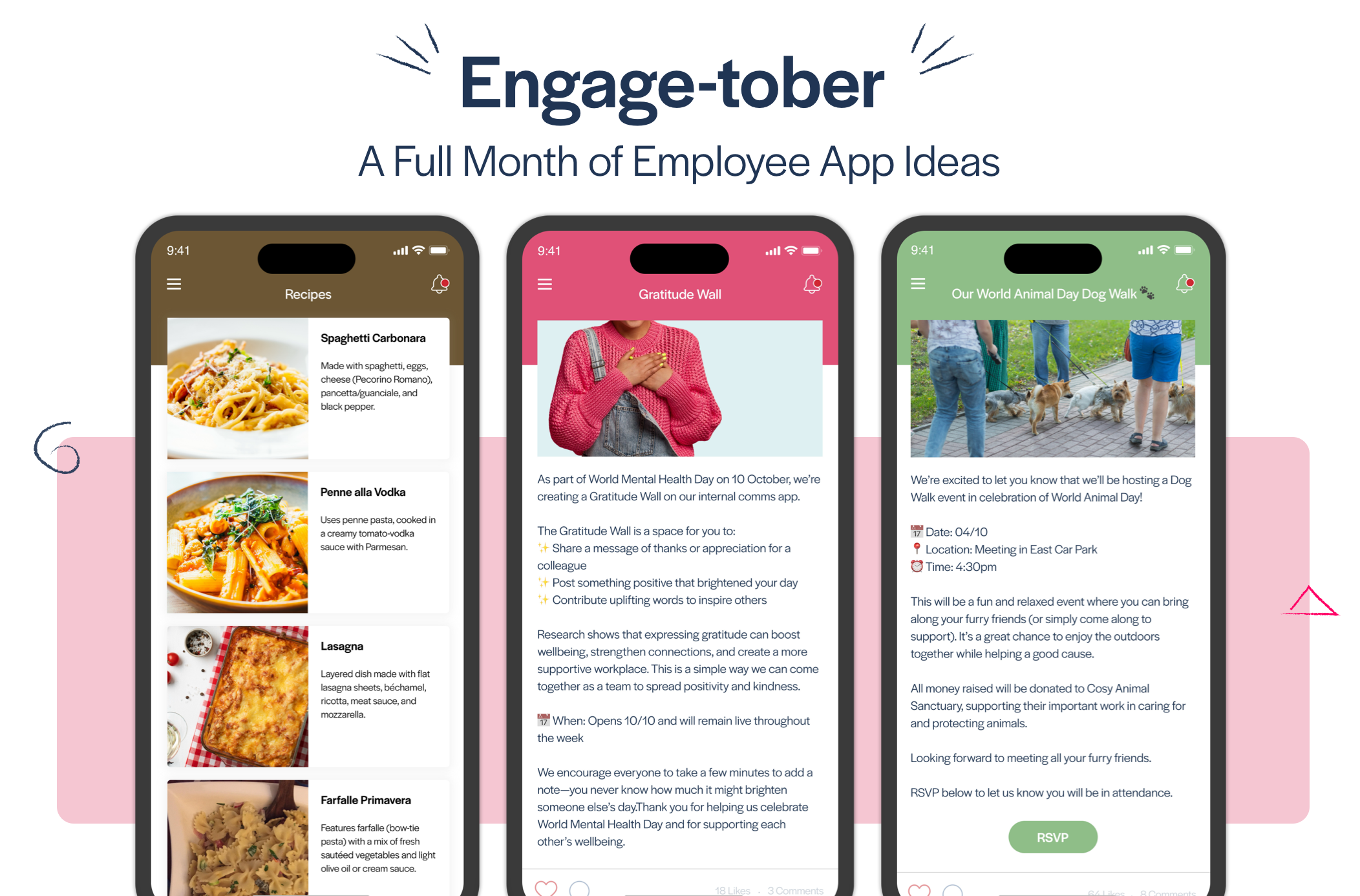
Blog
5 Essential Considerations for Measuring Your Employee App Success
We’ve teamed up with Jenni Field – current CIPR Vice President and Director of Redefining Communications, to come up with the five essential things to consider when measuring the success of your employee app.

When measuring the success or effectiveness of a digital platform like an employee app, it’s easy to fall into the trap of relying only on the numbers: the number of logins per week, the number of comments or likes, or the amount of employees with the app installed. While those stats are of course useful, they don’t tell the whole story. We’ve come up with the five following considerations to help you get a richer understanding of how to measure the success, impact and effectiveness of your employee app.
1. Be clear about what you want to measure and why
It’s tempting to want to measure every aspect of your app: the number of comments, downloads, engagements with user generated content, page views, and every other stat available in your Insights Dashboard. But it’s important to think about what each measurement is actually for. What does it achieve? For example, if you’re just measuring the amount of likes and comments to put into a monthly management report, then how is that helping you to show a correlation between business outcomes and the app’s value to the organisation?
You should have a clear rationale for each measurement you make, record and report on, and that links back to the reason that the organisation wanted an app in the first place. It’s okay that the app is not ‘all things to all people’. Your organisation likely had some clear reasons for wanting an app – perhaps based on feedback from employees. So, the stats that you’re measuring should be with the purpose of comparing the performance of the app against the reasons for the app existing.
If you aren’t clear on what those reasons are, or even how they might have changed or evolved since the app was introduced, then it’s time to reflect on your organisation’s current goals and the insights and feedback you’re getting from employees. This will give you a clear understanding of what impacts you want your app to make on your organisation. Set clear goals and measure against them.
2. Use Success Measures and Impact Measures
Stats don’t tell the whole story. You should not only measure the success of content, but also the impact of it. For example:
Success Measure: An article about our new company values is viewed by x% of app users within x weeks of publication.
Impact Measure: When we polled employees, or held focus groups to measure the understanding of new company values after the content was published, we saw an increase in knowledge from x% to y%
Simply measuring the number of views of a piece of content only tells you how many times that content has been viewed. It doesn’t tell you how effective that content has been in communicating the message that you’re trying to get across. It tells you how successful that content has been, but not how impactful. That’s a key difference when you consider that it’s very likely you introduced this app because you wanted to make a positive impact on the organisation and your employees.
Success measures are easy to access - you just have to open the Insights Dashboard in the Thrive Content Management System, and the data is right there! You have to work a bit harder to uncover those impact measures, but if you want the full picture you need both. An effective way to do this is through regular polling of your employees.
3. Polls can help you raise awareness and measure impacts
Poll questions can highlight content you want employees to be aware of, while also allowing you to measure awareness. For example, you could ask something like “Did you know about our new Cycle to Work scheme?” then provide a link below the poll to the article that talks about it.
This gives you some data as to how many people already knew about the policy (how many pageviews vs how many people chose yes or no), so it gives you information about how impactful your content about the Cycle to Work scheme was. But it also helps you raise awareness of it.
An employee app is the perfect channel to make use of this kind of polling, and it’s so easy to create a simple poll on a third-party site like SurveyMonkey or Typeform for example, then use an HTML embed code to embed the poll on to a page in your app. You can find instructions on how to do that here!
You can even do the same thing with app functionality that’s recently been introduced. In a previous blog post we discussed how to increase employee engagement with your app using our @mentions feature. You may have already created an article in your app to let your users know that they can now mention colleagues in the comments section, but if you want to measure the impact of that content, and continue to raise awareness of the new feature, a one-question poll on your app saying “Did you know you can use the @ symbol in comments to mention your colleagues and send them a notification?” can help you to do so. The poll question doesn’t even have to be its own separate page in your app. You can include a quick one-question poll at the end of an article about something different altogether.

4. Measurement Should Inform Strategy
You aren’t measuring the success of your app just so that you can put some figures in a management report. Ideally what you measure should have an impact on and inform your strategy for content and app promotion across the organisation. It should help you find out what kind of content works best and gets the most interest.
And don’t forget, ‘works best’ doesn’t necessarily mean ‘got the most views’ – always remember the difference between a Success Measure and an Impact Measure! Fundamentally your measurement should allow you to say “let’s do more of this because we know it works”, but at the same time it should highlight how employees are using your app so that you can explore additional functionality that can help you get your message across more effectively.
For example, let’s say you’ve been trying to make employees aware of your new organisational values, but your measurement is showing that the content related to that hasn’t been performing well and hasn’t been making much of an impact. You might then explore the idea of enabling our Peer-to-Peer recognition feature, where employees can say thanks to each other in your app and they have to choose of your organisational values to link their colleague’s behaviour to. That’s a really practical and employee-led way of promoting your organisation’s values, because the employees have to make that link between behaviour and value themselves.
If measurement is just to show usage for management reports, it won’t be having the impact it could have to help make the app as effective as it could be.
5. Comparison is the Thief of Joy
Benchmarking can be dangerous. We often get asked questions like “what percentage of our employees using the app should we be aiming for” or “how do we know what’s a good amount of comments to be getting on our content?” There are lots of different factors that contribute to the app usage stats of our customers. Things like organisational culture, leadership, employee morale, whether employees have had a digital platform like this previously. All of these things within your own business will have an impact on adoption and engagement so it’s important to focus on measures that work for you.
This goes back to our first point about being clear about what you want to measure and being clear about the reasons for the app’s existence. If you have a clear idea of what the app is for (and importantly, what the app is not for) then you’ll find it easier to set targets for things like app usage, comments and number of user posts, or to perhaps decide to ignore certain stats because they’re not telling you anything about whether the app is actually addressing the reasons for having got it in the first place. Rather than looking to compare or benchmark, set targets that are appropriate based what tools and channels you have already. You know your employees and your organisation better than anyone!









